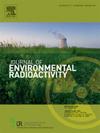Baseline tritium measurements in Thailand's water bodies: Supporting sustainable nuclear energy development
IF 2.1
3区 环境科学与生态学
Q3 ENVIRONMENTAL SCIENCES
引用次数: 0
Abstract
Tritium, a radioactive isotope produced naturally through cosmic radiation interactions and anthropogenically through nuclear weapons testing, poses potential environmental risks, particularly within the water cycle. This study measured tritium concentrations in surface water across Thailand to establish a baseline dataset for monitoring potential contamination from nuclear activities and accidents. Surface water samples were collected from 14 large reservoirs during the wet season in October 2023 and the dry season in February 2024, providing a total of 28 samples. Tritium concentrations were analyzed using electrolytic enrichment and liquid scintillation counting techniques. The results, presented with combined uncertainty, revealed tritium levels ranging from 1.21 ± 0.19 to 2.74 ± 0.23 TU (0.14 ± 0.02 to 0.32 ± 0.03 Bq·L−1), with an average of 1.94 ± 0.01 TU (0.23 ± 0.00 Bq·L−1). The highest concentrations were observed in the north (2.26 ± 0.02 TU), followed by the northeast (2.13 ± 0.04 TU), central (1.91 ± 0.05 TU), east (1.72 ± 0.03 TU), and south (1.55 ± 0.04 TU). All measured tritium levels were below the natural background threshold of 10 TU and complied with the surface water quality standards set by the Thailand's Pollution Control Department. Tritium concentrations were positively correlated with latitude, distance from the coast, and elevation, while showing an inverse relationship with pH. No significant seasonal variations or correlations were observed with ion concentrations, water temperature, electrical conductivity, salinity, dissolved oxygen, or total dissolved solids. These baseline measurements are essential for supporting sustainable nuclear energy development and ensuring effective monitoring of environmental radioactivity. The dataset provides a critical reference for Thailand's regulatory agencies, such as the Office of Atoms for Peace, to safeguard public and environmental safety under both normal operations and potential radiological emergency scenarios.
泰国水体中氚的基线测量:支持可持续核能发展。
氚是一种通过宇宙辐射相互作用自然产生和通过核武器试验人为产生的放射性同位素,具有潜在的环境风险,特别是在水循环中。这项研究测量了泰国各地地表水中的氚浓度,为监测核活动和事故的潜在污染建立了一个基线数据集。在2023年10月的丰水季和2024年2月的枯水季采集了14个大型水库的地表水样本,共提供了28个样本。氚浓度分析采用电解富集和液体闪烁计数技术。综合不确定度计算结果显示,氚含量范围为1.21±0.19 ~ 2.74±0.23 TU(0.14±0.02 ~ 0.32±0.03 Bq·L-1),平均值为1.94±0.01 TU(0.23±0.00 Bq·L-1)。浓度以北部最高(2.26±0.02 TU),其次为东北部(2.13±0.04 TU)、中部(1.91±0.05 TU)、东部(1.72±0.03 TU)和南部(1.55±0.04 TU)。所有测量到的氚含量都低于10 TU的自然背景阈值,并符合泰国污染控制部门制定的地表水质量标准。氚浓度与纬度、离海岸距离和海拔高度呈正相关,而与ph呈反比关系。与离子浓度、水温、电导率、盐度、溶解氧或总溶解固体没有显著的季节性变化或相关性。这些基线测量对于支持可持续核能发展和确保有效监测环境放射性至关重要。该数据集为泰国原子能促进和平办公室等监管机构在正常运行和潜在的辐射紧急情况下保障公共和环境安全提供了重要参考。
本文章由计算机程序翻译,如有差异,请以英文原文为准。
求助全文
约1分钟内获得全文
求助全文
来源期刊

Journal of environmental radioactivity
环境科学-环境科学
CiteScore
4.70
自引率
13.00%
发文量
209
审稿时长
73 days
期刊介绍:
The Journal of Environmental Radioactivity provides a coherent international forum for publication of original research or review papers on any aspect of the occurrence of radioactivity in natural systems.
Relevant subject areas range from applications of environmental radionuclides as mechanistic or timescale tracers of natural processes to assessments of the radioecological or radiological effects of ambient radioactivity. Papers deal with naturally occurring nuclides or with those created and released by man through nuclear weapons manufacture and testing, energy production, fuel-cycle technology, etc. Reports on radioactivity in the oceans, sediments, rivers, lakes, groundwaters, soils, atmosphere and all divisions of the biosphere are welcomed, but these should not simply be of a monitoring nature unless the data are particularly innovative.
 求助内容:
求助内容: 应助结果提醒方式:
应助结果提醒方式:


